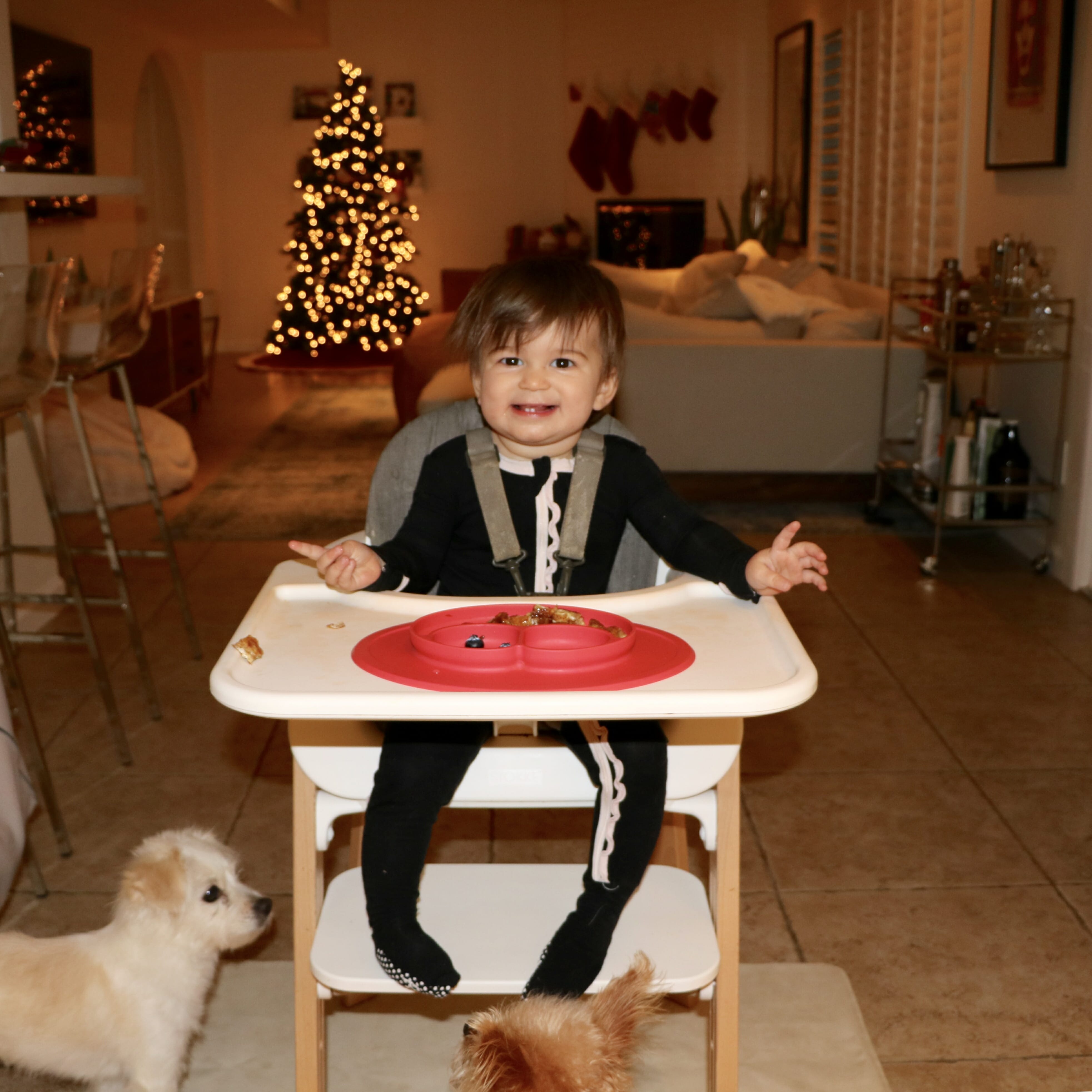Hi friends! I’ve been asked by a number of you to share what I feed Vivienne during mealtime. As you can see via IG story, I offer many different options throughout the week and try my best to put together the most nutritious meals as I can. Don’t worry, this isn’t a no French fry kind of post… I’m definitely a meet in the middle kind of mom. Since being a first-time mom and clearly not a certified dietician, I wouldn’t be able to sit here and write meal options for you with 100% confidence that I would be providing the BEST information possible. Therefore, I decided to bring in some experts, write down what I currently am doing, and have Megan and Judy weigh in and give their honest feedback for you. I was really excited about this collaborative post, as I love learning something new, even if its means that I am doing something wrong in the process.
The first question, Who are Feeding Littles?
Feeding Littles provides online courses and other resources to parents who want to teach their babies to eat real foods, prevent or manage picky eating, or learn how to deal with difficult mealtime behaviors. Feeding Littles is owned by dietitian Megan McNamee MPH, RDN and feeding therapist Judy Delaware, OTR/L. Megan and Judy work independently in private practice helping parents of children struggling with feeding issues, medical challenges, and nutrition or growth concerns. They share their expertise in an accessible, affordable way through their online courses and free Facebook group.
Second, what we use during mealtime.
This is not make it or break it when it comes to a successful mealtime with your little one, these are just the items that I am currently using with Vivienne and what you’ve often asked about.

Meal options during the week for Breakfast, Lunch, and Dinner:
Monday
Breakfast- Oatmeal with Almond Milk and Bananas (Awesome choices – stir in some peanut butter or almond butter for fat/protein. Fat is super important for babies, and even though almonds have fat, almond milk doesn’t have much.)
Lunch- Cheese Quesadilla, Salsa, Corn (Opt for whole grain tortillas when possible, and don’t be afraid to try some spice in that salsa! (Go slowly!))
Dinner- Pasta, Tomato, Chicken Sausage (Add another veggie here if possible – the main veggie (well, fruit) at lunch was tomato, so cooked broccoli, cucumber, cooked carrot or other leftover veggie would round out the day a little more.)
Tuesday
Breakfast- French Toast made with Eggs and Whole Grain toast and Cinnamon, blueberries (Try plain, full-fat Greek yogurt on top for a little boost of fat/protein. If you need to flavor it, stir in fruit or a dash of maple syrup, some cinnamon, and some vanilla.)
Lunch- Whole Grain Toast with PB or Hummus, Apple Sauce (Add a veggie if possible – an easy one is cooked from frozen peas.)
Dinner- Salmon, Cauliflower, Strawberries (Perfect – sounds delicious! It’s ideal to offer babies and toddlers fatty fish at least a few times a week, and salmon is a great option!)
Wednesday
Breakfast- Yogurt with Berries (Perfect! When possible, change the flavor/texture of the yogurt so your toddler doesn’t get used to the same thing over and over again. Stir in chia seeds or finely crushed nuts, or use different fruits to create a different flavor. The more variety you offer the better your toddler will eat.)
Lunch- Cheeseburger, fries, pickles (A simple addition to a faster lunch is fruit – a cutie, applesauce, or some banana could work here. I love that you serve her pickles!)
Dinner- Chicken, Mushroom, Pesto Orzo (Sounds great!)
Thursday
Breakfast- Egg, Oatmeal and Banana pancake (Top with almond butter or smashed raspberries for more nutrition and flavor.)
Lunch- Grapes, Grilled Cheese (To spruce up grilled cheese, use whole grain bread and stick a tomato slice next to the cheese.)
Dinner-Broccoli, Rice, Tofu (Don’t stress about brown rice if that’s what you use – it has 80% more arsenic than white rice, so I recommend eating both white and brown if you eat rice.)
Friday
Breakfast- Egg Quiche (Yum! Add some fruit like berries or quartered grapes to round it out a little bit more.)
Lunch- Chicken Nuggets, Mac and cheese (An easy addition to mac and cheese is cut up cooked broccoli florets, cooked peas, or even black beans – if you do this from the start your tot will be used to their mac and cheese being a little different each time. You can also stir in cooked butternut squash chunks or a little pumpkin puree.)
Dinner- Sweet Potato, lemon chicken, Broccoli (Perfect!)
Eating out options at restaurants:
Cheeseburger Sliders and Fries – (add avocado, sautéed mushrooms or tomato for a little nutrient boost. Get sweet potato fries if available.)
Mac and Cheese – (See if you can order it with veggies or beans added in, and pair it with some fruit if available. Many restaurants will do this if you ask! Also, I always avoid mac and cheese at restaurants if it comes from a box – I can easily do that at home and don’t need to pay a premium for someone else to make it!)
Chicken, Corn, and Potato – (awesome)
Grilled Cheese and Fruit – (Offer your toddler a few avocado slices from your sandwich or salad for a little bit more nutrition)

FAQ on mealtime:
What are some tips for parents to help their child drink from a sippy cup?
From Judy:
Always imitate what you want your child to do, so the best way to teach your child to drink from a small open cup is to let them practice with an open cup at home. Start with a small shot glass sized plastic cup with less than an ounce of water in it. Depending on the age of your child, he or she may not yet have the strength and control to bring a cup hand to mouth yet, so practice holding your hand over their hand. I say “1,2,3 take it away” so they don’t get too much water, and say “ahhh” after swallowing to promote emptying the mouth. Your child will imitate you the more you do this! As a feeding therapist, I cannot tell you how many 7-9 month olds I know who regularly say “ahhh” after swallowing some water! Bring the cup to the table and practice, practice, practice. It may be easier to practice open cups at meal and snack times when they’re seated, and use straw other closed cups while on the go. Types of open cups and other cups I like include:
- Doidy cup- the unique slant teaches the child to drink from a rim and not a spout.
- Lollaland Lollacup, or Zoli or Munchkin straw cups.
- Playtex Miracle 360 cup.
What is best to cook with? Oil or Butter?
From Megan:
Both! For a long time we’ve been told that “butter is bad,” but fortunately recent literature suggests that saturated fat was not as bad as we thought and in fact can have health-promoting properties. Butter from grass-fed animals is higher in both omega-3 fats and CLA, an anti-inflammatory compound. I recommend Kerrygold brand, found at most grocery stores and at Costco. I love cooking with olive and avocado oils.
Tips for eating out at restaurants?
From Judy:
- Start with family friendly locations.
- Do your best to go when it is less busy – decreased wait times.
- Choose a booth versus a table depending on the age and size of your child.
- Skip the kid menu and choose something that you would be willing to share with your child. If the item is known to be salty or a little spicy, ask the server to request the dish be made with a little less salt or spice, as you want to offer some to your child.
- Bring dry crunchy cereals or crackers and a “bag of magic” (new or unfamiliar toys) in the diaper bag. As soon as the food comes, put the magic bag and snack away.
- Ask your servers name, and make the meal as fun and stress-free as possible. Leave a nice tip for the staff who are left to clean up afterwards.
Is it OK to microwave leftovers?
From Megan:
Sure – just don’t microwave in plastic. My biggest issues with microwaves are the following:
- Leaching BPA or phthalates from a plastic container.
- The burn risk to a baby or child when microwaving formula or milk, since microwaves can heat unevenly and may create hot spots in the milk.
How do you deal with the mess at restaurants?
From Megan:
A good bib – like BapronBaby – and a nice tip. They get less messy as they get older and more experienced!
How big do you cut pieces of food for them to eat?
From Megan:
When they’re 6 months old, food should be cut into strips that are long enough for them to pick up. Young eaters lack the pincer grasp and can’t pick up tiny pieces. As they get older and refine the pincer grasp their food can be cut into bite-size pieces, but you can also vary the size of foods you offer.
What if my baby won’t eat meat?
From Megan:
Keep offering, and make sure the meat is moist. Babies and toddlers hate dry meat (don’t we all?). Offer meatballs, meatloaf, and meat/poultry/fish in the form of casseroles. Offer other non-meat sources of iron too, like beans, lentils, cooked leafy greens, nut butters and seed butters. Most babies don’t need meat for protein – they need it for iron. Protein needs are met through breast milk or formula, and protein needs for toddlers are lower than most people think (around 16-18 grams, which is a little more than 1 egg + 1 cup of milk).
What if my baby denies the entire meal?
From Megan:
Baby may be teething, becoming ill, not hungry or going through a developmental leap. Be consistent, eat in front of baby, make it fun and don’t pressure her. She may be more interested next time. The worst thing you can do is stop offering because baby refuses – exposure is critical. As your baby approaches 1, you can space out milk a little more from meals to promote more appetite for solid foods.
How to get your baby to drink more water?
From Megan:
We don’t want babies drinking water until 6+ months, and at that age we recommend no more than 1-2 ounces, max. Offer water in an open cup with each meal, and make it fun. Show baby how you drink water from an open cup or straw. Consistency and modeling will help your baby in the end! If you regularly drink from a fun cup (like a Starbucks cup), put some water in that and see if baby is interested. For older kids, the recommendation ranges a bit with a goal of 40 oz, but some sources recommend 4-6 cups (32-48 oz) total fluid daily. If your child isn’t drinking enough water, try the following:
- Add whole fruit or veggie infusions to the water in a clear pitcher your toddler can see. They’re often times intrigued by strawberry water or cucumber orange water.
- Let your child pick out her favorite cup or straw at the store.
- Offer high water foods like soups, cucumber, watermelon, and citrus.
- Make homemade popsicles with whole fruit, ice, and water blended together.
How do you determine portion size?
From Megan:
On average, a portion size is about 1 tablespoon per year of age. Thus, a portion of veggies for a one-year-old is about 1 tablespoon – much less than people think! However, that doesn’t mean a baby or toddler has to eat that amount of food or can’t have more. Keep the mantra “you provide, child decides” in your head when it comes to feeding your kids. You provide regular meals and snacks, and they decide how much to eat.
How to help baby from throwing food off high chair or throwing plate?
From Judy:
If something is thrown off the high chair, don’t immediately give it back to the child. This reinforces the throwing behavior. I have seen parents and children do a throwing dance repeatedly, and the child sees it as a game. The behavior is easily changed by the adult stopping the behavior and watching how the child responds. Ignore and re-direct, and praise your child for the behavior you’d like to see (“Great job keeping your food on your tray!). This approach can be used for most negative mealtime behaviors – ignore what you don’t want to see, redirect, and praise what you do want to see! You can also give the a “no thank you” bowl to throw foods into if they really want to keep throwing.
What’s your take on introducing cookies/candy?
From Megan:
You can start doing cookies when you are comfortable- at Vivienne’s age, she doesn’t get that they’re around so you can wait. No need to serve them to her a ton but she will be OK if she tries it. Its good for them to learn about sweets and see them as just an other food. Those snacks (especially Cheerios because they are high in iron) are OK, although there are more nutritious options to mix in here and there too. Consider freeze dried peas or strawberries, black beans, string cheese, or cut up fruit instead.
From Megan and Judy:
In general, some of the most important mealtime behaviors include:
- No devices on the table (no TVs on during mealtime).
- Consistent meals and snacks with regular routines.
- Fun, low-stress mealtime – no bribery, forcing your child to eat, or watching every bite.
- Offer tons of variety in flavor, texture and presentation – your child will learn to eat what you serve.
- Avoid using food as a reward or punishment. We want our kids to see food as food, not “good” vs “bad” or something they get when they’re behaving a certain way.
Need more help? Join our FREE Facebook group: facebook.com/groups/feedinglittlesgroup Use code LOLA18 for $10 off either of our online courses (Infant or Toddler) through 1/31/18 at feedinglittles.com.
